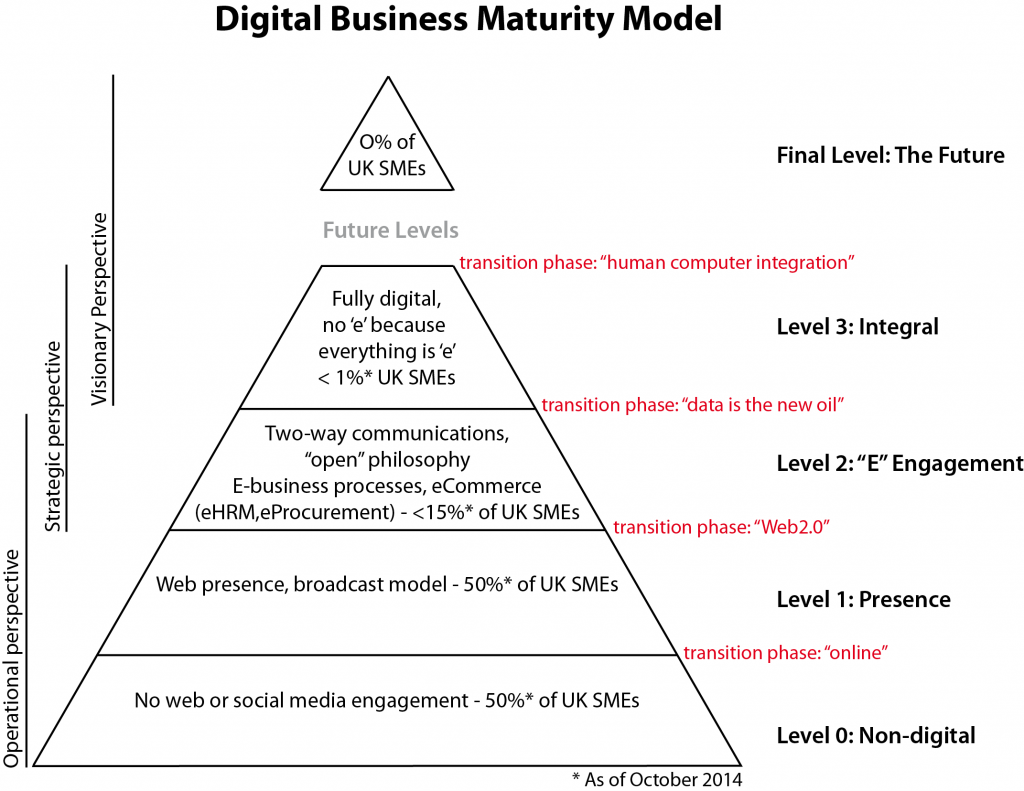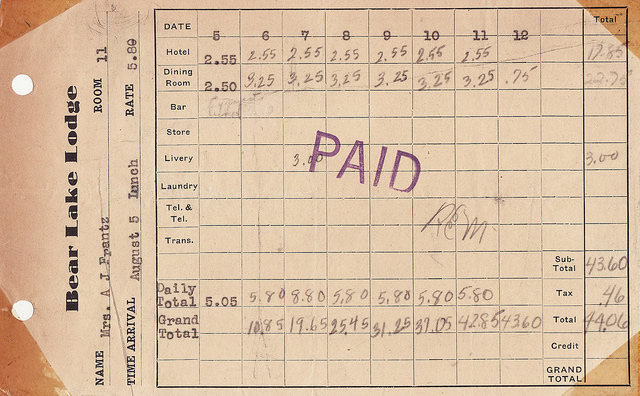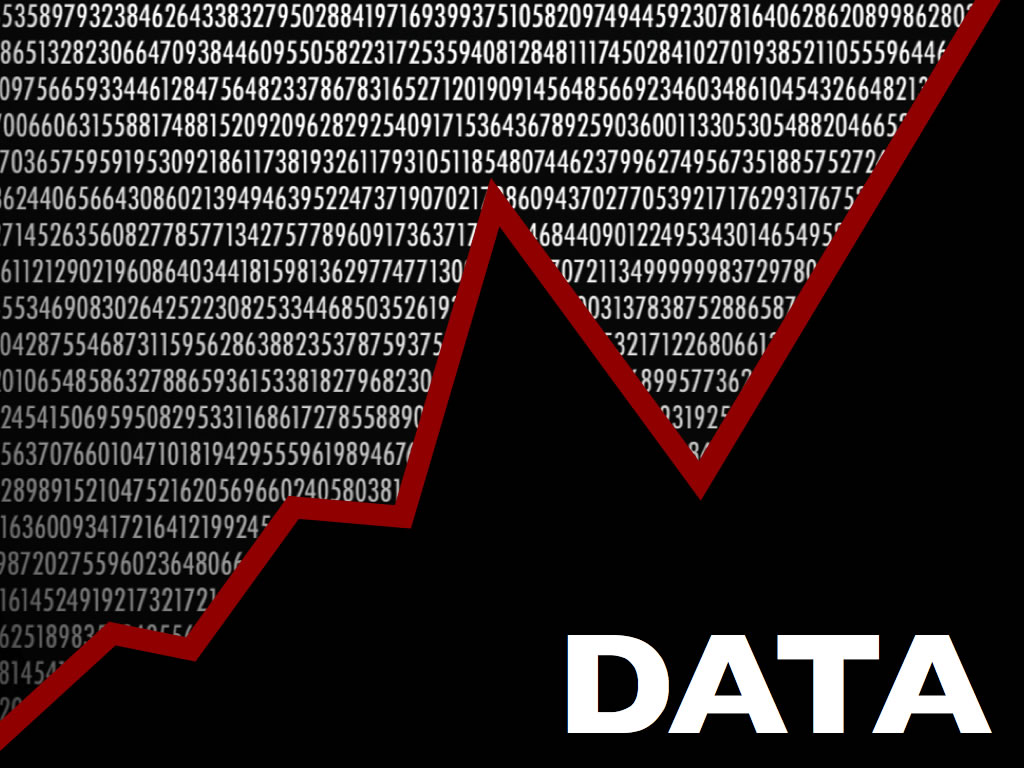
At the Centre for Digital Business we have recently been discussing what digital business is, the future of digital business and ways to understand the stages of digital development for any business.
The contrasts between Small and Medium-sized Enterprises (SMEs) and Large Multi-national Organisations (LMOs) are usually quite obvious in any comparative survey of business maturity or readiness.
But, digital is different.
For example, size, in terms of any conventional measure such as the number of employees, annual turnover or worse – in the first few years for a digital start-up at least – profit, become a bit confused in the world of digital business.
The measures of maturity and potential business success, we argue, are better measured through descriptors including ‘online’, ‘engaged’, ‘presence’ and ‘engaging’. But, more challenging descriptors are also required such as ‘integrated’, ‘new oil’ and ‘open’.
Most challenging of all, the most advanced forms of digital business will be ‘e’-less as this awkward prefix becomes meaningless and old fashioned in the same way that “online” is becoming replaced by “omni channel” for more cutting edge marketers. What is being recognised with the use of this term is the seamless integration of communications with consumers regardless of whether they are on a mobile device, website, social media network, phone or a long train journey.
Digital Business Maturity Model
To help refine our thinking and to be able to more readily explain these levels of digital business development to small businesses and colleagues as well as policymakers we use what we have come to term the “Digital Business Maturity Model.”
The first key point to note is that unlike other business models the Digital Business Maturity Model is intended to evolve. There are currently five levels to this model illustrated in the diagram above. But, as a digital business continues to develop from Operational and Strategic viewpoints to ultimately a Visionary perspective, digital business becomes increasingly ubiquitous. New technologies enable the development of greater evidence based decision making processes within a business and will add more levels to the Digital Business Maturity Model between Level 3 and what we describe as the “Final Level”.
Level 0 – Digital Business Maturity Model
Paper Receipt (CC) by Calsidyrose
At least half of SMEs in the UK still exist at Level 0 of the model. These businesses are not online in any meaningful way. Any automatic presence may have been created for them in one of the many online business directories that pollute Google, and other search engine results pages (SERPs) but a business owner has no control or input into the information being presented about their own organisation.
On the operational side these businesses are still likely to be using paper based invoicing and accounting methods as well as record keeping that might involve the minimal use of computers.
Many of these businesses will almost certainly exist on review sites with comments attached to the profile that observe, “no website – rubbish” or “can’t contact them – no email address”. For these many businesses – up to 50% of all SMEs in the UK as of 2014 – their digital business challenge is to get online and develop their own presence.
Level 1 – Digital Business Maturity Model
Megaphone (CC) by Mary Ann Clarke SCott
For the 50% or so of UK SMEs that do have some form of online presence – what we describe as Level 1 in the Digital Business Maturity Model – the challenge is to move from simply broadcasting what they believe is important about their business to ‘doing’ their business digitally.
For retailers this resolves to concepts of eCommerce and selling online via own website or through other major online market places such as eBay, Amazon or industry verticals such as Auto Trader and Rightmove. But, for these and the vast range of other business types the task is to engage, really engage, with their prospects and their future clients who are already online.
Operationally, organisations at Level 1 would be using digital technologies in a passive way – for example they would publish content on the website and send out email to customers. In the background they will almost certainly have adopted the use of an accounting package and perhaps other customer relationship management systems such as a mailing list and a database of orders.
Recognising the importance and opportunity of online presence drives businesses to want to engage and interact. In effect, it is Web 2.0 for the rest of the world after the geeks got bored and moved on.
Level 2 – Digital Business Maturity Model
Internet (CC) by photosteve101
Search engine optimisation (SEO) and social media marketing are among the techniques that can assist a business to move from Level 1 to Level 2 of the model. But, to genuinely jump to Level 2 it also requires some strategic thinking and positioning as well as the embracing of potentially alien business philosophies.
For traditional businesses the move to becoming an ‘open’ digital business is frightening as the illusion of control must be given up in order to build up an alliance with customers that allows words like co-creation and co-design to be used meaningfully. With this perspective the customer is now an ally rather than the enemy (who must have money extracted from them at every opportunity and every transaction).
A successful Google Ad Words campaign will only bring potential allies to the front door, it is the opportunity to co-create that throws that door wide open and a Level 2 digital business emerges.
Moving to Level 2 throws into question all aspects of a business’s activities and processes. “Can these be done differently?” “Is different better?” Level 2 requires the strategic vision to question the status quo. This is one reason why only about 15% of businesses in the UK currently ‘sell’ on top of their online presence. Being too bogged down in day-to-day operational reality will prevent all but the most determined business owner from changing (non-digital) profitable practice for something that is untested and new.
Operationally, at level 2 an organisation would have an operational information system that allows some reporting and integration between multiple channels that offers the ability to achieve operational efficiencies.
Level 3 – Digital Business Maturity Model
Data – new Oil (CC) by Tom Woodward
The transition to Level 3 of digital business maturity takes even greater strategic determination and levels of long term leadership and innovation. The Level 3 digital business is ‘e’-nothing and ‘e’-everything at the same time. Everything is digital and with the awareness of the significance of ‘digital everything’ new revenue streams can open up.
“Data is the new oil” already seems clichéd to some technology commentators. Yet so few UK businesses are at this level of awareness that it will still need to be said many more times in the popular media.
The current ‘big’ agenda for Level 3 digital businesses revolves around the generally still speculative Internet of Things – the massive integration of tangible things with the Internet as digital accessible items. In this world a refrigerator placing a repeat order for Milk or where a car makes a phone call to the emergency services are normal and expected capabilities.
But there are still many other innovations that can bring organisations and customers closer together in a digital way:
Digital Business Future vision
Many of the business cases for the Internet of Things are still to be written but some already exist. However, in many business sectors achieving significant business system and process integration would represent a positive step into the territory of Level 3 digital business maturity.
Level 4 – The Future – Digital Business Maturity Model
Back to the future (CC) by Andrés Nieto Porras
For the most ambitious and visionary business the final level of digital business maturity is always unattainable but in the attempt to reach this level new business models and processes emerge and are created. This route to digital business maturity takes real and persistent vision that incorporates acknowledgement (rather than disregard) for all the risks that this approach and drive presents.
The current impetus on quantifying digital business success centres around analytics and metrics that count the interaction of customers and potential customers with a business’s online presence. In terms of digital business maturity we can only currently measure degrees of success with any degree of precision at Level 1. At level 2 digital maturity only eCommerce success can be fully measured and evaluated. Tools that take into account external factors and alter operational tasks such as weather related Pay Per Click advertising automation, at Level 4 would allow the development of new products and services demanded (and needed) by the customers.
At level 4 operational realities become so closely linked to visionary innovations that co-production and co-design with customers blurs traditional boundaries and relationships thoroughly.
How do you progress your business to the next level of maturity?
The Salford MBA is the first in the world to offer a Digital Business MBA pathway – this programme offers a good theoretic understanding of the opportunities and challenges ahead for business managers. The encouraging observation for all businesses contemplating a long haul from Level 0 or 1 of digital business maturity is that individual progress is not necessarily a linear evolution. With sufficient vision, openness, drive and – most importantly – original ideas, a business has the potential to leapfrog levels.
What do you think? Can you think of ways to accelerate a business’s digital maturity?






About that digital business maturity model.
115% ?
Have you been watching too much of The Apprentice?
Thanks for publishing this research. If only the other 50% of SMEs knew
the power of the web for their sales and leads etc! Further more, if
there’s a skills gap currently, I can see it only worsening as these SME’s come
online, or maybe the skills gap is the reason that there is no focus on
that end of the market?